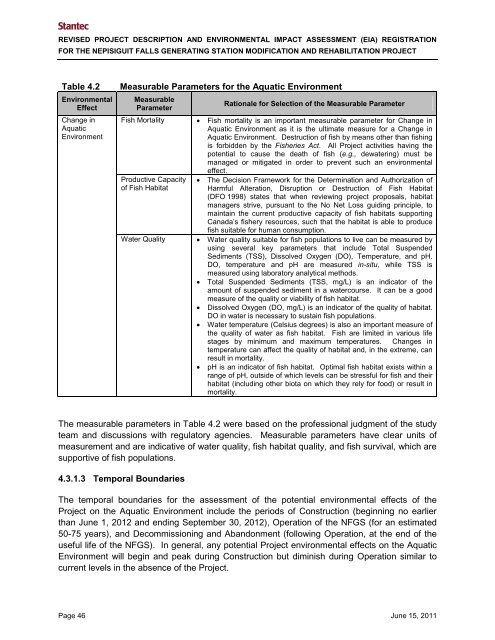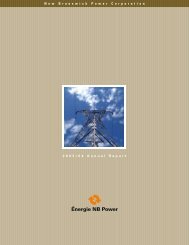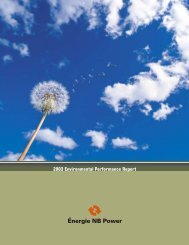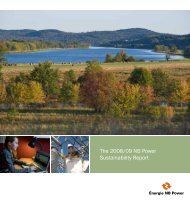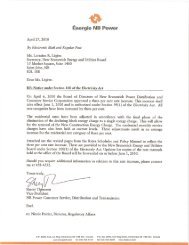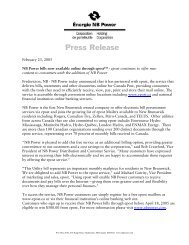Environmental Impact Assessment(EIA) Registration for the ...
Environmental Impact Assessment(EIA) Registration for the ...
Environmental Impact Assessment(EIA) Registration for the ...
You also want an ePaper? Increase the reach of your titles
YUMPU automatically turns print PDFs into web optimized ePapers that Google loves.
REVISED PROJECT DESCRIPTION AND ENVIRONMENTAL IMPACT ASSESSMENT (<strong>EIA</strong>) REGISTRATION<br />
FOR THE NEPISIGUIT FALLS GENERATING STATION MODIFICATION AND REHABILITATION PROJECT<br />
Table 4.2<br />
<strong>Environmental</strong><br />
Effect<br />
Change in<br />
Aquatic<br />
Environment<br />
Measurable Parameters <strong>for</strong> <strong>the</strong> Aquatic Environment<br />
Measurable<br />
Parameter<br />
Rationale <strong>for</strong> Selection of <strong>the</strong> Measurable Parameter<br />
Fish Mortality • Fish mortality is an important measurable parameter <strong>for</strong> Change in<br />
Aquatic Environment as it is <strong>the</strong> ultimate measure <strong>for</strong> a Change in<br />
Aquatic Environment. Destruction of fish by means o<strong>the</strong>r than fishing<br />
is <strong>for</strong>bidden by <strong>the</strong> Fisheries Act. All Project activities having <strong>the</strong><br />
potential to cause <strong>the</strong> death of fish (e.g., dewatering) must be<br />
managed or mitigated in order to prevent such an environmental<br />
Productive Capacity<br />
of Fish Habitat<br />
effect.<br />
• The Decision Framework <strong>for</strong> <strong>the</strong> Determination and Authorization of<br />
Harmful Alteration, Disruption or Destruction of Fish Habitat<br />
(DFO 1998) states that when reviewing project proposals, habitat<br />
managers strive, pursuant to <strong>the</strong> No Net Loss guiding principle, to<br />
maintain <strong>the</strong> current productive capacity of fish habitats supporting<br />
Canada’s fishery resources, such that <strong>the</strong> habitat is able to produce<br />
fish suitable <strong>for</strong> human consumption.<br />
Water Quality • Water quality suitable <strong>for</strong> fish populations to live can be measured by<br />
using several key parameters that include Total Suspended<br />
Sediments (TSS), Dissolved Oxygen (DO), Temperature, and pH.<br />
DO, temperature and pH are measured in-situ, while TSS is<br />
measured using laboratory analytical methods.<br />
• Total Suspended Sediments (TSS, mg/L) is an indicator of <strong>the</strong><br />
amount of suspended sediment in a watercourse. It can be a good<br />
measure of <strong>the</strong> quality or viability of fish habitat.<br />
• Dissolved Oxygen (DO, mg/L) is an indicator of <strong>the</strong> quality of habitat.<br />
DO in water is necessary to sustain fish populations.<br />
• Water temperature (Celsius degrees) is also an important measure of<br />
<strong>the</strong> quality of water as fish habitat. Fish are limited in various life<br />
stages by minimum and maximum temperatures. Changes in<br />
temperature can affect <strong>the</strong> quality of habitat and, in <strong>the</strong> extreme, can<br />
result in mortality.<br />
• pH is an indicator of fish habitat. Optimal fish habitat exists within a<br />
range of pH, outside of which levels can be stressful <strong>for</strong> fish and <strong>the</strong>ir<br />
habitat (including o<strong>the</strong>r biota on which <strong>the</strong>y rely <strong>for</strong> food) or result in<br />
mortality.<br />
The measurable parameters in Table 4.2 were based on <strong>the</strong> professional judgment of <strong>the</strong> study<br />
team and discussions with regulatory agencies. Measurable parameters have clear units of<br />
measurement and are indicative of water quality, fish habitat quality, and fish survival, which are<br />
supportive of fish populations.<br />
4.3.1.3 Temporal Boundaries<br />
The temporal boundaries <strong>for</strong> <strong>the</strong> assessment of <strong>the</strong> potential environmental effects of <strong>the</strong><br />
Project on <strong>the</strong> Aquatic Environment include <strong>the</strong> periods of Construction (beginning no earlier<br />
than June 1, 2012 and ending September 30, 2012), Operation of <strong>the</strong> NFGS (<strong>for</strong> an estimated<br />
50-75 years), and Decommissioning and Abandonment (following Operation, at <strong>the</strong> end of <strong>the</strong><br />
useful life of <strong>the</strong> NFGS). In general, any potential Project environmental effects on <strong>the</strong> Aquatic<br />
Environment will begin and peak during Construction but diminish during Operation similar to<br />
current levels in <strong>the</strong> absence of <strong>the</strong> Project.<br />
Page 46 June 15, 2011


